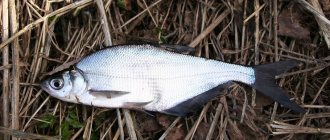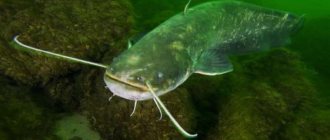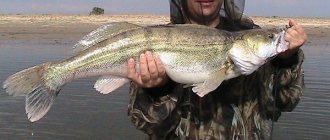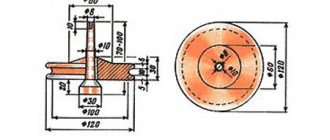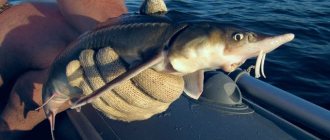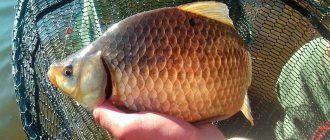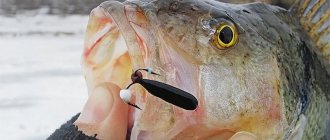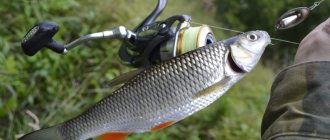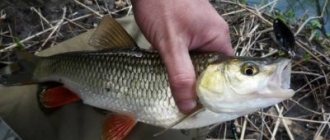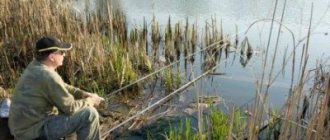Personal experience of gudgeon fishing - what to catch and how?
The gudgeon is a fish popular among fishermen; from its name you can tell that it lives on a sandy bottom.
It is found in any body of water and usually at the bottom of the reservoir. This is a fish that lives in schools, and in a school it can be of different ages. In summer it is found in shallows or well-warmed pits. Accordingly, we can understand that this fish is heat-loving. They catch him with a float rod. About 4 or 5 years ago I went to visit my brother in the village, they have fisheries there, where there are large crucian carp and gudgeon, and also, like, bitterling.
We arrived early in the morning at the fishing spot (note to you) and caught a lot of minnows and crucian carp. That's when I first learned about this type of fish. In the morning it bites well, but when the sun starts to get hot, the bite subsides. The bait saved us; as soon as you throw it into the water, the gudgeon will immediately show itself; for such fishing, I use store-bought bait.
You can add a little bait to the groundbait, but only the one you are fishing with. For scent, you can add flavoring to the bait (strawberry and vanilla work well in the summer). Worms (both earthworms and dung worms), grasshoppers, flies, bloodworms, and maggots (work, but a little worse than a worm) work well as bait. You can also offer plant bait, but the fishing is much better with animal bait.
The gudgeon grows to a small size, but due to its length it appears healthy. Minnows are distinguished by age; if the fish is old, then it is dark in color, and if it is young, then it is light in color. This fish is diurnal and prefers to move and eat during the day; at night it is at depth and completely motionless. In extreme heat, he can stand in one place for hours. The gudgeon is very sensitive to water; if the water is dirty or contaminated with something, then it will die first, so it needs clean and running water.
In autumn it is more active than in summer, and catching it is not difficult. You need to look in holes and snags. I recommend fishing with bait of animal origin. In the fall, like other fish, it tries to gain fat to make the winter easier. Do not use a thick fishing line, this is not the kind of fish that will tear it for you. Tie a small hook.
In winter I was not able to catch it (who knows, maybe you will catch it). It overwinters in the mud. If anyone caught a gudgeon, it was most likely an accident. The smallest jig is used as gear (wiring must be done from the bottom). Bloodworms (artificial or live) are used as bait.
Spawning of gudgeon begins, like roach, in late April - early May. By the way, it spawns in flocks in the smallest areas of a reservoir, stake, or river. Its caviar has a bluish tint. After about a week of spawning, he again begins to actively feed until warmer weather arrives. As soon as various mollusks, crustaceans, etc. come to life in the water, it becomes more difficult to catch it. Practice shows that you need to use bait, for a sharper smell, I add a few drops of “Anise”, the main thing is not to overdo it (2 – 3 drops per 1 kilogram of bait is enough).
Fishing for gudgeon can hardly be called labor-intensive. Many people catch minnows as live bait, but many also catch them for themselves.
We wish you an awesome bite and a big catch in your bucket!
How to choose a place and what to catch minnows with
Cool flowing water bodies with a hard bottom (sand, stone, pebbles, clay) can be considered promising for fishing. Sandy shallow waters, rocky river riffles, well-heated pits and dumps at moderate depths are optimal for gudgeon fishing.
The gudgeon will only bite on bait of animal origin. As for bread, dough, cereals and other vegetable attachments, they are of little use.
The iron ore worm can be considered a universal bait, but since it is included in the Red Book of the Russian Federation, it is better to abandon this idea and use other baits.
The gudgeon is well caught on bloodworms, maggots, honeydew and caddis larvae, and dung worms. The first two are planted either individually or in a bunch of several pieces. It is best to use the worm in sections, without forming a tail that hangs down too long.
Fishing for gudgeon does not require bait. The exception is earthen balls with the addition of chopped worms and bloodworms, which, when released into the water, create a cloud of turbidity that attracts fish.
But in general, the gudgeon presents great deviations both in color (old ones are always darker) and in the shape of the body and head. It has been noticed that in the northern parts of Russia the gudgeon is much sharper than in the south; in Moscow province. All fishermen distinguish it from the ordinary black minnow.
But in general, the gudgeon presents great deviations both in color (old ones are always darker) and in the shape of the body and head. It has been noticed that in the northern parts of Russia the gudgeon is much sharper than in the south; in Moscow province. All fishermen distinguish it from the ordinary black minnow.
However, on the rifts the gudgeon hides behind rocks, and... rises upward here with pushes from one defense to another.
In Western Europe, especially in France, where the gudgeon enjoys great respect, much more than in our country the ruffe and even the burbot, these methods, very simple and handy, are very common. Firstly, a lot of gudgeons are caught here with special small and frequent small capes, which are thrown from a boat or a deep bank, after first stirring up the water with a pole or oar. But for us the game is not worth the candle; This fishing is difficult, and it is unlikely that anyone in Russia will catch such a small thing this way.
They are caught on the rise - from locks, bridges, especially floating ones, gangways and rafts, less often by wading and from boats. Before lowering the net to the bottom, the water is strongly stirred up - this is necessary, since the turbidity is, as we will see later, the main bait for the gudgeon.
There, instead of tops, they use very original equipment, namely horse and bull skulls, which are immersed in water at certain places. Minnows enter the skull through the occipital foramen and, when quickly rising, do not have time to get out.
As for the time of day, the gudgeon, like a daytime fish, takes the bait only from sunrise to sunset, and with the onset of darkness the biting stops. It takes best in the early morning shortly after sunrise. It bites the worst during the day, especially in hot weather. The state of the weather seems to have a small influence on the intensity of the bite of this fish, but before bad weather you will never catch many of them. On the contrary, after rain, when the water becomes somewhat cloudy, the gudgeon takes more greedily.
Tips for fisherman: Crucian carp killer, what it is, how to catch it - Detailed review
The bait is mainly either a dung worm or a bloodworm: the first - in spring and summer, the second - in autumn, from August. In quieter places it is better to fish with a whole worm or half; on riffles, it is more profitable to plant a piece of a red worm or, even better, a piece of an ordinary iron ore worm, like a ruff. Bloodworms are attached, as always, by threading the hook tip below the head, in the amount of 1-3 pieces.
As for other baits, they are of little use for catching this fish. Not only do minnows not take any kind of bread bait (however, I once caught 2 minnows on bread in Lake Beloe), but they are not particularly willing to grab, for example, maggots and ant eggs; The latter is more likely to be caught by bluets than blacks.
However, the small bluegill, which has a relatively small mouth, bites relatively very sluggishly, hesitantly and often sucks bloodworms, which is why fishermen, if they catch a bluegill, immediately change their place.
The gudgeon is a very tenacious fish and is almost irreplaceable as bait for predatory fish. In Western Europe it is considered an excellent food fish for salmon, and in England it is often kept for a long time in troughs and baths. When using the described blowing devices, minnows can be transported over considerable distances.
In our country, gudgeons are mostly used for fish soup, and often together with ruffs, since fish soup made from minnows alone, almost devoid of mucus, is not very rich. Less often, minnows are eaten in a frying pan with sour cream. The French are big fans of minnows fried in onions or crushed breadcrumbs, in Provençal butter. Gudgeon soup is a very light and digestible food and is given even to feverish people. Minnow meat is white and somewhat sweet. Lake gudgeon, especially pond gudgeon, always smells somewhat like mud.
In this article you will learn what is good about fishing for gudgeon, as well as the features of fishing and what this tasty river fish bites on.
Where and what to catch in the game Real Fishing
In the Real Fishing , fish, as the name of the application emphasizes, are found in their inherent ecological zones, so it will not be possible to catch a piranha in a forest river. Here is a little hint for Real Fishing players, where and what to catch.
Let's start with Real Fishing for crucian carp:
- Found in crucian carp pond (depth 260) and forest lake (150 centimeters).
- Caught with semolina or bait.
- It goes best during the day.
Real Sturgeon Fishing:
- Volga, depth 390-475 centimeters.
- Near the shore it is fishing for a worm, in the distance only for a mollusk.
- Any time of the day except night.
Real Bream Fishing:
- Pisces. Hoz, about 315-350 cm.
- Pasta, peas.
- It’s better to start from night to morning.
Real Carp Fishing:
- Karasev pond at a depth of 230-240 centimeters.
- Cheese.
- Regardless of the time of day.
Tench Real Fishing caught:
- Ice lake.
- Depth about 190-200.
- On cheese or from the bottom on pineapple oil.
Real Minnow Fishing:
- Second location, depth 240.
- Works great on a fly.
- All day long.
Real Fishing for Silver Carp:
- Volga at a depth of 375.
- It bites on corn.
- The peak occurs in the morning.
Real Pike Fishing:
- The first location and Moshka, depth is about 165-185 centimeters.
- Meat or live bait;
- In the morning from 6 to 11 and in the evening from 18 to 23.
What to use to catch minnows in winter
With the right choice of place for targeted fishing, gudgeon fishing in winter is never boring. It is important to decide what is the most promising way to catch gudgeon in winter. It is the fisherman’s decision to feed the fish or do without feeding. If bait is used, it is important to prepare it only to attract fish, and not to saturate it.
Any bait for carp fish in cold water is suitable. You can use briquettes of instant cake. A minimum of food supply is added: finely chopped worms or food bloodworms. The bait is delivered in small portions.
Winter fishing rod for minnow
Minnows are caught from the ice using any available methods used for catching live bait in winter. Winter gear for gudgeon is mounted taking into account the possible passing bite of perch, roach, crucian carp or rudd. This is relevant when catching gudgeon with a winter fishing rod.
The most exciting fishing for gudgeon in winter is done with a winter fishing rod with a nod. Installation of a winter fishing rod for a minnow:
- It is convenient to use short winter fishing rods up to 30 cm long. The whip should not be too hard. Otherwise, the likelihood of the fish’s lip breaking or falling off as a result of hooking will increase;
- Fishing line – 0.08-0.14 mm;
- The nod should encourage play with a jig or bait on a hook;
- The weight, together with the weight of the attached bait, should deflect the nod by 30-60 degrees;
- Hooks or jigs No. 3-4.
When catching gudgeon from ice, it is better to use bait: red worms, bloodworms or their edible rubber analogues.
Technique for catching gudgeon with a winter fishing rod
Several holes are made in a promising area. Additionally, you can prepare separate holes for bait delivery, although this is not necessary. The optimal number of gear is 2-3 pieces. One tackle is used for active play with a jig or bait, while the others are installed permanently. The bait sinks to the bottom surface and then rises a few centimeters.
Playing with a jig is performed near the surface of the bottom. You should not perform swings with high amplitude. In winter, gudgeon will not chase bait that floats away abruptly.
The gudgeon bites decisively. It is important to perform timely cutting. Retrieving even a trophy minnow onto the ice surface does not create problems.
Winter trap for minnow
You can make a trap for catching minnows from ice with your own hands. A cage with a fine mesh net that uses only 2 lower hoops is suitable. The top hoops are trimmed and removed. The throat tightening rope remains.
How to catch a minnow with a trap
An ice hole is being prepared to fit the diameter of the trap. A feeder with bait is fixed at the bottom of the trap. For prompt delivery, additional cargo is tied to the bottom. The mesh above the second hoop is rolled up with the expectation that after placing the trap on the bottom, access to the bait is open.
The concentration of minnows in clear water can be observed without additional equipment. When lifted, the cage is tightened and the caught fish is removed from the ice hole. This method of catching gudgeon in winter is usually used to quickly catch live bait.
It should be noted that many highly catchable artificial baits are made to catch predatory fish, and fishing with live bait is prohibited in many countries. Worth thinking about! Maybe gudgeon will become available in domestic reservoirs, as it was several decades ago.
About gudgeon
The gudgeon is a small fish that, strangely enough, belongs to the carp family. Occasionally it reaches a length of 20 cm. But usually its length does not exceed 10 cm. The gudgeon is easy to distinguish from other fish by its cylindrical body, back with a greenish tint, and along the silvery sides there are black, sometimes blue, spots. Along the edges of the mouth there is a pair of antennae. Sometimes the color of the gudgeon, depending on the reservoir, may differ, be darker or lighter.
Fishing for gudgeon, in addition to being simply interesting, is often associated with the fact that this fish is an excellent live bait and can be used as bait for any predatory fish. The gudgeon is especially to the taste of such predators as pike, pike perch and burbot. But, as I said above, any predator does not mind feasting on them.
Where to catch minnow
The gudgeon can live in any type of reservoir, but is more often found in places with weak or moderate currents. The gudgeon is also not a rare guest in ponds. Prefers places with a sandy or rocky bottom. It is found very rarely at depth; it prefers shallow places near the shore. Usually, already a couple of meters from the shore, at a depth of half a meter, you can find significant schools of minnows, in which there are individuals of different ages and sizes. In clear water and a light sandy bottom, you can go waist-deep or even knee-deep into the water to catch a gudgeon, which allows a person to come quite close and is practically not afraid of feet.
The gudgeon leads an exclusively bottom-dwelling lifestyle and it is very rare to see one not attached to the bottom. In the warm season, gudgeon should be looked for in shallow places that are well warmed by the sun. If it is a river, the gudgeon usually warms itself near the rifts, and, just like at the rates, on the sandbanks. It also likes a bottom covered with small pebbles. And only with the onset of cold weather in the fall does it begin to move to deeper places and look for holes for wintering.
When to catch minnow
Minnows can be caught all year round. In the warm season it is shallow, and with the onset of cold weather and winter in deeper places and holes.
During the period of good gudgeon bite, on a small nickle of a reservoir 2 by 2 meters, you can catch 150 or more gudgeons. In the morning hours, minnows lie in numerous schools on the bottom and seem to be waiting for food to float to them at any moment. And when you throw bait into this school, a fight for it begins and each gudgeon tries to be the first to grab it, so the gudgeon bites do not take long to arrive.
How and what to catch minnows with
The gudgeon is a fish that is not at all picky about bait. If it bites, it will bite equally on both maggots and bloodworms, although many sources recommend bloodworms as the best bait for gudgeon. I also agree that the gudgeon bites worse on plant and grain bait, but on animal bait, in my opinion, its bite is the same, and it doesn’t matter what’s on the hook - maggot, bloodworm or worm. Therefore, an ordinary dung worm will be enough for you to successfully catch this fish.
When fishing with a fishing rod, of course, it will not be relevant to use long rods; there are also no special requirements for the fishing line, since the gudgeon is not particularly careful, but of course it is better to take a thinner fishing line, the gudgeon will definitely not tear it, and a thinner fishing line will distract its attention from the bait smaller, a fishing line with a diameter no thicker than 0.15 mm is best. A gudgeon can cling to any hook, but it will be more difficult to hook it on a large one, so they usually use a small hook No. 3. In order to better see the bite of this small fish, it is better to choose a lighter float.
Personally, I caught minnows on a piece of fishing line with a hook tied to it, without any fishing rods or floats. The water was clear, and the bottom was sandy, clearly visible, on which schools of minnows were very clearly visible. I went into the water, the water was just above my knees or waist-deep, and looked out for minnows. Usually they were located on islands of sand between plants growing at the bottom. In these schools there were always several large minnows, and the rest were smaller. Seeing a gudgeon, I lowered the hook with a worm on it and almost immediately the fish grabbed my bait, naturally immediately hooked and went into the bag prepared for the catch. I could catch more than a hundred minnows while practically staying in place. The interest of such fishing is that you see the bite not through the float, but as the fish attacks your bait, trying to get ahead of its relatives and choosing the right moment to hook.
What to catch minnows with
Depending on the fishing conditions, the type of bait is selected, but the main bait for catching it is a worm.
At the same time, he actively pecks both at the whole worm and at its pieces. When fishing in a river, on a current, it is enough to attach a small piece of a worm and a bite will be guaranteed. In areas where there is no current, it is better to fish with a whole worm or half. At the same time, the gudgeon does not refuse bloodworms, which are placed on the hook in 2-3 pieces, prying it below the head. He takes this bait best closer to autumn. At this time, many fishermen prefer bait of animal origin. Closer to autumn, he fishes more effectively with a small worm: in the depths you should fish with a whole worm, and in the shallows with its halves. At the same time, it bites better on dung worms. Most likely this is due to the fact that the dung worm, unlike the earthworm, is smaller, but at the same time, it behaves more actively on the hook. He is reluctant to take maggots and bait of plant origin, as well as ant eggs. As a rule, gudgeons are caught on worms all year round, which indicates that this is their favorite bait.
At the height of summer, when it is hot outside, the gudgeon is not averse to trying pearl barley or wheat. Active gudgeon biting is observed in the morning and evening.
Mechanics of catching minnows on lakes.
Fishing for gudgeon on the lakes itself is very simple. All you need to take is a small portion of loose food, as well as bait of animal origin (worm, maggot or bloodworm). Minnows usually like to look for food close to the shore, so you should take a fishing rod with you about three to five meters long.
Fish such as crucian carp and rotan can also be found on lakes, so catching only minnows can be difficult. And if rotan is not very interested in bait, it likes to hide in the grass near the shore, then crucian carp is very fond of bait and is able to drive minnows away from it. If this happens, it is necessary to resume biting the gudgeon by feeding it in a new place.
In order to catch this fish on a fishing rod, you need to have a light float and a small and thin hook, because this fish is not very large and heavy equipment can scare away the minnow.
Also, to catch gudgeon, it is necessary to use floats with a carrying capacity of one gram for lakes and water without a current. A small depth should be enough for this. You need to set the depth of the float so that part of the leash line, about 3-5 centimeters, touches the bottom. If the fish bites poorly or the gudgeon behaves cautiously, you need to make sure that the hook with bait almost does not touch the bottom. The gudgeon is not very picky, so any bait can be used for feeding. It would be nice to add a few chopped worms to the bait or take a few handfuls of bloodworms.
Minnow fishing
At first glance, gudgeon fishing may seem like a frivolous activity, worthy only of children. This fish is very small and inconspicuous, and fishing quickly gets boring. However, for a real fisherman, a gudgeon is of very considerable value, because it is considered one of the best live baits when catching large chub, river pike, or burbot.
There are gourmets who claim that fried gudgeon is a delicacy. I don’t argue, because I myself have repeatedly eaten this fish, “dried” in vegetable oil until crispy. I will say this - an excellent snack, it tastes like sunflower seeds. However, for food purposes it is much more advisable to use a large gudgeon - about 25 centimeters long (we will talk about where to look for such monsters below). True, it comes across much less often than the usual small ones, not exceeding 15 centimeters in length.
You can also use gudgeon to make homemade canned fish. Judging by the reviews, sprats made from it turn out excellent. There is only one depressing thing - cleaning this little thing while cooking is a routine and terribly dreary task. However, I digress.
Actually, gudgeon fishing can be divided into two directions. The first is the massive production of fish (regardless of its size). The second is targeted hunting for large minnows.
Regarding mass gudgeon fishing, what is important for the fisherman is, first of all, the time during which the required amount of fish will be caught. That’s why he doesn’t stand on ceremony with his gear and uses all sorts of “poaching” traps, like muzzles made of plastic bottles, or lifts made of fine mesh. They allow you to quickly and literally in one sitting get the required amount of live bait. Or food, depending on your choice.
If you don’t have such gear, you can fish for a gudgeon using a half-bottom made from an ordinary float rod. To do this, the float moves almost to the very tip of the rod. A piece of worm is attached to the hook (the gudgeon generally loves small baits), and then it is thrown into a school of gudgeons, which usually stand in the first sandy and pebble shallow water that comes across - not far from the shore. The bite follows immediately, fortunately the small minnow bites all daylight hours. In this way, you can fish out minnows one after another - until you get tired of it, which for sure (for a mentally healthy fisherman) will happen already in the second ten, or even earlier.
When fishing for gudgeon, bait is not needed, because the fish are already walking in a dense school. However, you can lure them to a specific place by raising mud there, which gudgeons quickly run into before other fish. Full-fledged bait, most likely, is devoid of any meaning here. Although, when fishing with a lift, it may be quite in demand - to quickly force the fish to gather above the net.
But “hunting” for a large minnow is a completely different matter. It’s funny, but this fish also has its own “large size”. As a rule, these are very old and experienced individuals who have escaped the teeth of a pike, a chub’s mouth or a seagull’s beak. These minnows, which is especially interesting, differ from their small counterparts not only in their truly “giant” size, but also in their behavior pattern. They are suspicious and cautious, as a rule, they stay alone and choose parking places so that they have somewhere to hide if suddenly a predator appears out of the blue. Their element is not pebbly shallow waters, but deeper places with a rocky bottom and stripes of underwater vegetation (for example, elodea). During the day, large minnows do not bite at all - they feed exclusively at dawn, and in June, sometimes, they feed on fat all day long.
I myself, and my companions, have caught large minnows on the bottom more than once. Naturally, everything happened by accident - while catching another fish. The picture was always the same: late evening (or early morning), the bell rings, you drag it out - it looks like there is something, but small, you pull it out - winder trees! A real barbel is not a minnow! That's all. Only one. It has never happened that at least two such “giants” were caught from one place. Among other things, we also noticed the following trend - the smaller the river, the greater the chances of catching a large gudgeon in it. This one (as much as 20 cm long!) was once caught in the Bolshoi Shishim River - in a pit.
Bait and groundbait for catching gudgeon.
1. In the winter season, gudgeons are well caught using bloodworms.
2. In the spring, rosehip can be an excellent bait for catching minnows. The size of the bait directly depends on the size of the fish caught.
3. The minnow likes the worm at any time, this is one of his
about the most favorite baits.
4. You can take any type of bait; the gudgeon is not a very picky fish in this regard, but it would be best to stir up the bottom silt with your feet before using the bait.
Mechanics of catching minnows in rivers.
Fishing for gudgeon on the river is much more interesting than on the lakes. Despite the vast distribution areas of the gudgeon, it is not possible to fish for this fish everywhere; it is distributed only in certain places; it likes a bottom made of sand or stone. In straight sections of the river with a very slow current, this fish is very difficult to find, although sometimes it is also found there.
To successfully catch a gudgeon, you need not to stand in the same place, but to constantly look for its new habitats and feeding areas. This tactic determines what kind of fishing rod you need to use: strong, very light and short, with a reel. The length of the rod should be approximately 4-5 meters, it is possible to use a mast telescopic rod, its use allows you to quickly change position. The fishing line should be approximately 0.15-0.17 millimeters thick. It is better not to use a heavy float 2-6 grams, depending on the power of the water flow and the depth of the bottom in the river. Due to the strong current, do not heavily load the float.
The gudgeon looks for food exclusively at the bottom, so the hook with bait should practically not touch the bottom. The hook should be small because the minnow has a small mouth. The best size is number 20-18. Therefore, the bait should be used in small pieces. The gudgeon likes any bait of animal origin.
Fishing for minnows is a very exciting and interesting activity for both beginners in fishing and professionals. Using these simple techniques will allow you to successfully catch this fish both in lakes and rivers.
Tackle and bait
The fish itself is small, so thin equipment is required, otherwise there will be rare bites or there will be none at all. For winter fishing for minnows, you should purchase a separate winter fishing rod for small species of fish, which includes minnows.
The bait used is a jig, which weighs about 0.2 grams. The fishing line used is 0.06-0.7mm in diameter. Such gear will ensure effective fishing for winter gudgeon. Coarser gear is not required. Make sure that the jig has a small thin sharp hook - No. 18-20. For bait, use bloodworms. It is a thin hook that allows you to attach a bloodworm well, which on such a hook will be active for quite a long time, attracting minnows.
In principle, in winter, gudgeons go well with a baitless jig or other types of bait, but the most effective way to catch gudgeon in winter is with a jig with bloodworms. A winter fishing rod for gudgeon should be chosen with a sensitive nod: the gudgeon is a small fish, it is quite possible to miss a bite. During a winter bite, the nod sharply drops down, and almost always such a bite is followed by a successful hook.
Thus, when preparing winter equipment for minnows, you should not forget that it is necessary:
- take about 0.2 g of jig;
- use thin fishing line, with a diameter of 0.06-0.07 mm;
- take a thin small hook No. 18-20;
- choose a fishing rod with a very sensitive nod;
- Use bloodworms for bait.
Post by garbar76 » Nov 17, 2014 1:53 pm
Gudgeon
Post by Sinigr » 01 Apr 2014, 12:24
Re: Minnow
Post by skvoznyak » Jun 09, 2014, 11:29 am
Re: Minnow
Post by garbar76 » Nov 17, 2014 1:53 pm
Re: Minnow
Post by Old » 11 Jan 2015, 20:36
Re: Minnow
Post by Zoya » Jan 24, 2015, 00:04
Re: Minnow
Post by alexis1977 » Jan 25, 2015 03:48 pm
Re: Minnow
Post by k0mp0t » Jan 26, 2015, 7:35 pm
Tips for a fisherman: What to catch for crucian carp pond rotan - Tips for a beginner
Re: Minnow
Post by k0mp0t » Jan 26, 2015, 7:41 pm
The gudgeon is a small and nimble fish, a typical inhabitant of rivers and flowing reservoirs. Despite its small size, the gudgeon is very popular among fishermen: thanks to its vitality and mobility, it is one of the best live baits for catching predatory fish species. In addition, it has an excellent taste when fried or dried, and gives a unique taste and aroma to the fish soup made from it.
The gudgeon is a small and nimble fish, a typical inhabitant of rivers and flowing reservoirs. Despite its small size, the gudgeon is very popular among fishermen: thanks to its vitality and mobility, it is one of the best live baits for catching predatory fish species. In addition, it has an excellent taste when fried or dried, and gives a unique taste and aroma to the fish soup made from it.
The choice of bait for fishing depends on the season: • In spring, on rivers with medium and strong currents, the gudgeon actively bites on pieces of dung worms and shitik; • In summer, in addition to worms and shite, you can catch gudgeons using steamed vegetable baits such as wheat and pearl barley; • In the fall, just before the cold weather, the gudgeon better takes 2-3 bloodworms on a hook. This fish has little or no success with maggots, chafer larvae, and ants. Tackle
To catch gudgeon in the open water season, use a simple summer float rod, consisting of a 5-meter carbon fiber Bolognese rod, a small bobbin or spinning reel, fishing line with a cross-section of 0.14 mm, a float with a weight of 0.5-1.0 g, 15- 20 cm leash made of monofilament 0.12 mm thick with hook No. 10-12.
In winter, however, as in the period of open water, gudgeon leads a diurnal lifestyle. With the onset of night it becomes motionless and settles down on the surface of the bottom. Fish activity increases during the thaw. During the freeze-up period, it feeds on the remains of aquatic vegetation and invertebrate bottom larvae. It rarely rises to higher levels of water: only to escape from active predatory fish.
Mechanics of catching minnows on lakes.
Fishing for gudgeon on the lakes itself is very simple. All you need to take is a small portion of loose food, as well as bait of animal origin (worm, maggot or bloodworm). Minnows usually like to look for food close to the shore, so you should take a fishing rod with you about three to five meters long.
Fish such as crucian carp and rotan can also be found on lakes, so catching only minnows can be difficult. And if rotan is not very interested in bait, it likes to hide in the grass near the shore, then crucian carp is very fond of bait and is able to drive minnows away from it. If this happens, it is necessary to resume biting the gudgeon by feeding it in a new place.
In order to catch this fish on a fishing rod, you need to have a light float and a small and thin hook, because this fish is not very large and heavy equipment can scare away the minnow.
Also, to catch gudgeon, it is necessary to use floats with a carrying capacity of one gram for lakes and water without a current. A small depth should be enough for this. You need to set the depth of the float so that part of the leash line, about 3-5 centimeters, touches the bottom. If the fish bites poorly or the gudgeon behaves cautiously, you need to make sure that the hook with bait almost does not touch the bottom. The gudgeon is not very picky, so any bait can be used for feeding. It would be nice to add a few chopped worms to the bait or take a few handfuls of bloodworms.
Bait and groundbait for catching gudgeon.
1. In the winter season, gudgeons are well caught using bloodworms.
2. In the spring, rosehip can be an excellent bait for catching minnows. The size of the bait directly depends on the size of the fish caught.
3. The minnow likes the worm at any time, this is one of his
about the most favorite baits.
4. You can take any type of bait; the gudgeon is not a very picky fish in this regard, but it would be best to stir up the bottom silt with your feet before using the bait.
Mechanics of catching minnows in rivers.
Fishing for gudgeon on the river is much more interesting than on the lakes. Despite the vast distribution areas of the gudgeon, it is not possible to fish for this fish everywhere; it is distributed only in certain places; it likes a bottom made of sand or stone. In straight sections of the river with a very slow current, this fish is very difficult to find, although sometimes it is also found there.
To successfully catch a gudgeon, you need not to stand in the same place, but to constantly look for its new habitats and feeding areas. This tactic determines what kind of fishing rod you need to use: strong, very light and short, with a reel. The length of the rod should be approximately 4-5 meters, it is possible to use a mast telescopic rod, its use allows you to quickly change position. The fishing line should be approximately 0.15-0.17 millimeters thick. It is better not to use a heavy float 2-6 grams, depending on the power of the water flow and the depth of the bottom in the river. Due to the strong current, do not heavily load the float.
The gudgeon looks for food exclusively at the bottom, so the hook with bait should practically not touch the bottom. The hook should be small because the minnow has a small mouth. The best size is number 20-18. Therefore, the bait should be used in small pieces. The gudgeon likes any bait of animal origin.
Fishing for minnows is a very exciting and interesting activity for both beginners in fishing and professionals. Using these simple techniques will allow you to successfully catch this fish both in lakes and rivers.
Real Fishing
Version: 1.10.5.500 Genre:
Simulation
Latest game update in the header: 26.03.2019
Short description:
Fishing simulator.
Description:
We present to your attention the best fishing simulator! A real paradise for a fisherman awaits you: - 21 superbly designed locations - More than 210 types of different fish - Wide selection of fishing tackle - More than 30 types of bait and 30 lures - More than 160 exciting quests - Realistic weather simulation that affects the habits of fish - Different types of fish are caught at different times of the day - Possibility to fish with 2 fishing rods at once - Wide selection of fishing gear: Float rod, spinning rod, donka - Unique winter location - fish with special winter baits - Chat with other fishermen at each location - Share record weights of fish caught in the chat chat - Online tournaments for competition with other players - Three types of echo sounders for comfortable fishing - Colorful collections with unique cards of fish and fishing accessories - More than 50 game achievements - Simulation of the number of fish in a location
The simulator presents a very realistic biting system: - Different fish bite in different weather - Game baits correspond to the baits used for real fishing - For each fish there is a preferred fishing depth - Simulation of the movement of schools around the location, for effective fishing you need to change the casting location
Google Play free version (with advertising, 3 locations available):
https://play.google.co….andromeda.truefishing
Google Play key (removes ads, unlocks all locations):
https://play.google.co…omeda.truefishing.full
Discussion of hacking the game and distribution of the full version of the game is strictly prohibited!
Russian interface:
Yes
System requirements:
Android 4.1+
Download:
Version 1.10.5.500:
Реальная Рыбалка (Пост Dark Zhnets #83756271)
Version 1.10.5.501:
501.apk ( 28.14 MB )
With requests for game updates, please contact the topic Обновите РеРіСЂСѓ!
Post edited by HoRRicH
— Today, 13:29
Methods for catching minnows
As you know, gudgeons are caught using float and lead rods. However, the decisive factor is the bait, which allows you to achieve the greatest success. In winter, they use a float rod or jig to catch minnows.
Catching gudgeon in a wade
To attract a gudgeon to a place, you don’t need excessively strong tricks - just stir up the soil that has settled at the bottom of the reservoir. This method of catching gudgeon is called wading. It consists of the fact that the fisherman enters the water in the traditional habitat of the fish (for minnows these are areas above the riffles) and muddies the water with his feet. In the resulting “suspension,” the minnows rise upward and may even touch the fisherman’s boots.
Fishing for minnows
For this kind of gudgeon fishing, take the lightest fishing rod with a small hook and a small float. You can also fish for gudgeon using a half-bottom fishing rod. A pellet of the required mass is selected as a load. They catch with such gear in the wiring. The depth is set by eye, making sure that the bait drags straight along the bottom. Any stop of the float is responded to with a soft hook. With this method of catching gudgeon, stirring up the water with your feet or a pole is also suitable.
Catching gudgeon with a self-submersible float
A similar method of catching gudgeon is practiced in shallow water with fast currents. Since the gudgeon is predominantly a bottom-dweller, it is best to keep the bait at bottom level. Particularly active bites are observed when the bait is dragged along its surface. Often, 2 hooks are used on a fishing line: the lower one is placed 5-10 centimeters from the upper one, which is tied on a short leash.
Float rod for catching minnows
Catching a gudgeon by retrieving does not always bring success, since it is so lazy that it will not take off and pursue a quickly floating bait. Therefore, fishing with a line without touching the bottom with a sinker is practiced only in quiet areas of water, where there are a lot of gudgeon and he waits for the food to swim straight into his mouth. If a minnow notices that a tasty morsel is slipping away, it can pursue it for a short distance. When the fish is standing on a fairly fast stream, it makes sense to fish the retrieve by dragging the nozzle and sinker along the bottom. The length of the leash should not exceed 10 cm. It is better to choose a pear-shaped float with a slightly larger carrying capacity than usual, so that it does not dive when the equipment hits a pebble or sand, but continues to drag the sinker, leash and hook with a nozzle along the very bottom in the current . In this case, stopping and slightly lowering the float is a signal of a gudgeon bite.
On the shallows of lakes and ponds with little current, the length of the leash may be slightly longer, and the float will be suitable with a narrower body. Since gudgeon fishing almost always takes place in shallow water, where the fishing depth rarely exceeds 2 m, when rigging a float rod, I always use one weight element attached close to the leader, if necessary. However, when you fish with the sinker and bait dragging along the bottom, there is a risk of snagging. Then you need to use a leash made of a thinner fishing line to avoid losing the entire line. If you fish on pond shallows free of grass and snags, then you can easily do without a leash.
Catching gudgeon with a side nod and a jig
Tackle structure with a side nod and a jig This light and mobile tackle, consisting of a telescopic rod 4-5 m long, a foam reel “filly”, a long nod, a piece of fishing line with a diameter of 0.15 mm, the length of the rod and a jig, is convenient for fishing gudgeons in sections of the river with currents of different speeds.
When playing the bait “on the rise”, minnows rarely pursue it. Considering that gudgeons in fast currents like to stand behind small water obstacles, it is worth lowering the jig to the bottom behind the stones. If the fish stand behind each other in the stream, bites may follow one after another. To activate a school of minnows, it is useful to lightly stretch the jig along the ground, keeping the line taut, and then return it to its original position, that is, make the bait freeze in a lull behind some pebble. It is better to use small or very small jigs with a hook No. 16-18. The best attachment for a jig is a piece of a small worm. Small fish with a bad bite fiddle with the bait for a long time or only tug at it, so it is very important to catch the moment to hook.
Donka and half-bottom for catching gudgeon
On various types of donkeys, gudgeons are caught along the way when catching other fish. Sometimes it will grab the worm when you fish on vast sandbanks or rocky rifts. However, donka is a rough tackle for gudgeon, sometimes you don’t even see a bite. You just take out the equipment to recast, and a small fish hangs on it. You can catch a gudgeon with a half-bottom more purposefully.
The fishing line for minnow half-bottoms (taking into account the rocky bottom or other catchy places) must be set with a diameter of at least 0.14 mm; leash - 0.12 mm. The float should not be too heavy, but such that under its weight, taking into account the strength of the current, a slight sag of the fishing line is formed, which allows you to notice any, even the weakest bite. It is best to catch a gudgeon with a half-bottom when it is completely calm. If the wind is blowing and the current is uneven, a weak gudgeon bite may not be noticed at all.
